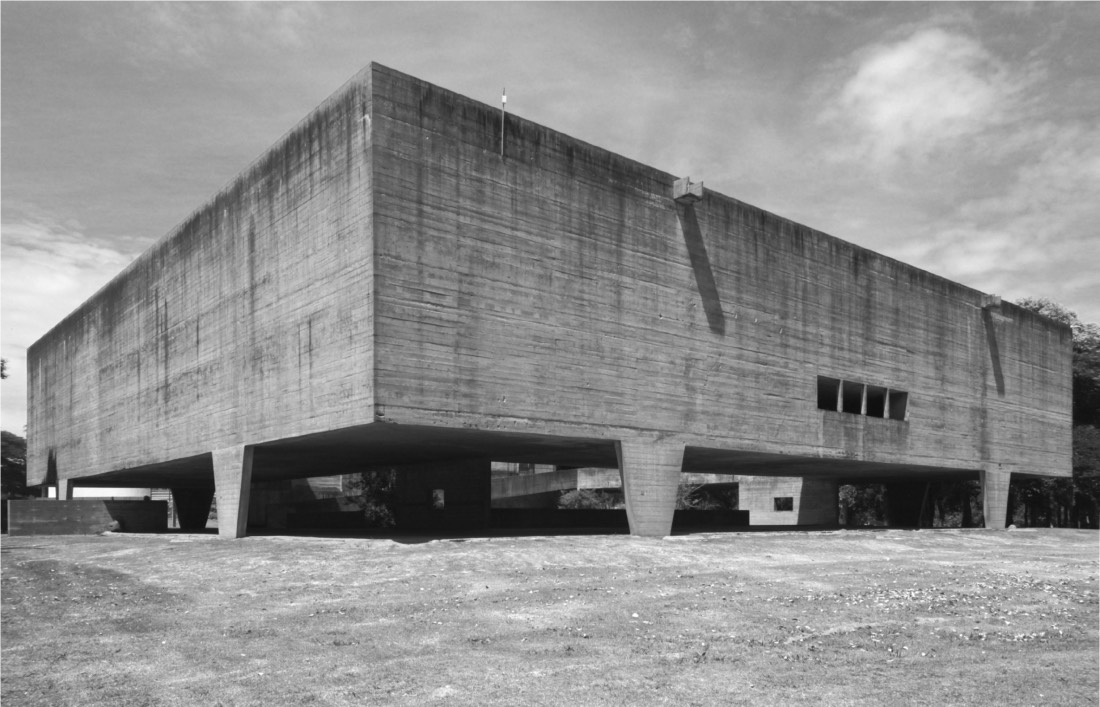El Urnario Municipal de Montevideo
Narrativas, argumentos y representaciones historiográficas
DOI:
https://doi.org/10.18861/ania.2022.12.2.3306Palabras clave:
Historiografía, historia, desarrollismo, arquitectura, modernidad, hormigón expuesto, brutalismo, Uruguay, América LatinaResumen
El urnario municipal número 2 fue proyectado durante el año 1959, en las oficinas municipales, por Nelson Bayardo y José Pedro Tizze para albergar urnas funerarias. La arriesgada y potente estructura de hormigón armado expuesto se construyó entre 1960 y 1961 en el Cementerio del Norte. El edificio se instaló cercano a un lago natural formado por una vertiente del arroyo Miguelete, aislado en el paisaje pintoresco que resultó de la expansión del parque, trazado por Luis Crespi a comienzos de los años 50. Apenas concluida la obra, el escultor Edwin Studer realizó el gran mural que cubre toda la superficie del muro orientado al norte, en el patio interno.
Los valores que la obra detenta fueron presentados en diversas publicaciones locales y extranjeras. En este artículo se exploran las argumentaciones realizadas sobre el edificio publicadas en medios de prensa, libros y revistas. Se han considerado aquellos textos y notas que aportan puntos de vista significativos, ofrecen interpretaciones y que utilizan imágenes para apoyar los argumentos.
La intención es revisar aquellos relatos que lograron instalar este edificio como una pieza insoslayable, en primer lugar, para comprender la arquitectura realizada en Uruguay. Ubicado junto a las obras de ladrillo de Eladio Dieste y Mario Payssé Reyes, el urnario completa la trilogía canónica local ofreciéndose como contrapunto por su material. Los escritos cumplieron una tarea aún más importante, reconocer la obra como un ejemplo clave de la llamada red brutalista de América Latina. El análisis historiográfico cumple una tercera función, establecer un punto de partida para nuevos estudios.
Descargas
Citas
Artucio, L.C. (1971). Montevideo y la arquitectura moderna. Montevideo: Nuestra Tierra.
Bayardo, N. (1965). Ha muerto Le Corbusier. Revista de la Facultad de Arquitectura, (6), 4-6.
Bayardo, N. (1963). Urnario del Cementerio del Norte. Revista de la Facultad de Arquitectura, (4), 8-17.
Bergdoll, B.; Comas, C.; Liernur, F.; y del Real, P.(2015). Latin Americain Construction: Architecture 1955-1980 Nueva York: MoMA.
Bullrich, F. (1969). Nuevos caminos de la arquitectura latinoamericana. Barcelona: Blume.
Bullrich, F. (1970). Arquitectura latinoamericana: 1930-1970. Buenos Aires: Sudamericana.
Bullrich, F. (1964). Cinco obras en Uruguay. Revista Summa, (3),40-47.
Browne, E. (1988). Otra arquitectura en América Latina. México D. F.: Gustavo Gili.
L'Architecture d'aujourd'hui. Architecture Sacrée, n° 125, abril-mayo 1966.
Le Corbusier (1948). Cuando las Catedrales eran blancas. Un viaje al país de los tímidos. Buenos Aires: Poseidón.
Lorente Mourelle, R. y Ramiro Bascans (1970). Uruguay. Panorama de su arquitectura contemporánea. Revista Summa, (27), 21-60.
Lousteau, C. (2 de febrero de 1975. La influencia de Le Corbusier o el poder de la literatura. El Día, Supl., s/p.
Nudelman, J.(2015). Tres visitantes en Paris. Los colaboradores uruguayos de Le Corbusier. Montevideo: CSIC.
Vera, L. (13 de diciembre de 1962). El urnario del cementerio del norte. Una obra del arquitecto Nelson Bayardo. Diario Época, s/p.

Publicado
Cómo citar
Número
Sección
Licencia
Derechos de autor 2022 Mary Mendez

Esta obra está bajo una licencia internacional Creative Commons Atribución 4.0.
El contenido de los artículos publicados es responsabilidad exclusiva de sus autores y no reflejan necesariamente las opiniones del Comité Editorial, ni de los evaluadores.
La revista Anales de Investigación en Arquitectura preserva los derechos de los autores, que son adoptados por Comité Editorial para su publicación. Los autores declaran que el trabajo presentado es inédito y no ha sido publicado en una revista científica o en una monografía.
La revista Anales de Investigación en Arquitectura proporciona un acceso abierto a sus contenidos, basados en el principio de la licencia internacional Creative Commons Reconocimiento 4.0 International License, que ofrece al público un acceso libre a las investigaciones para ayudar a un mayor intercambio global del conocimiento.

